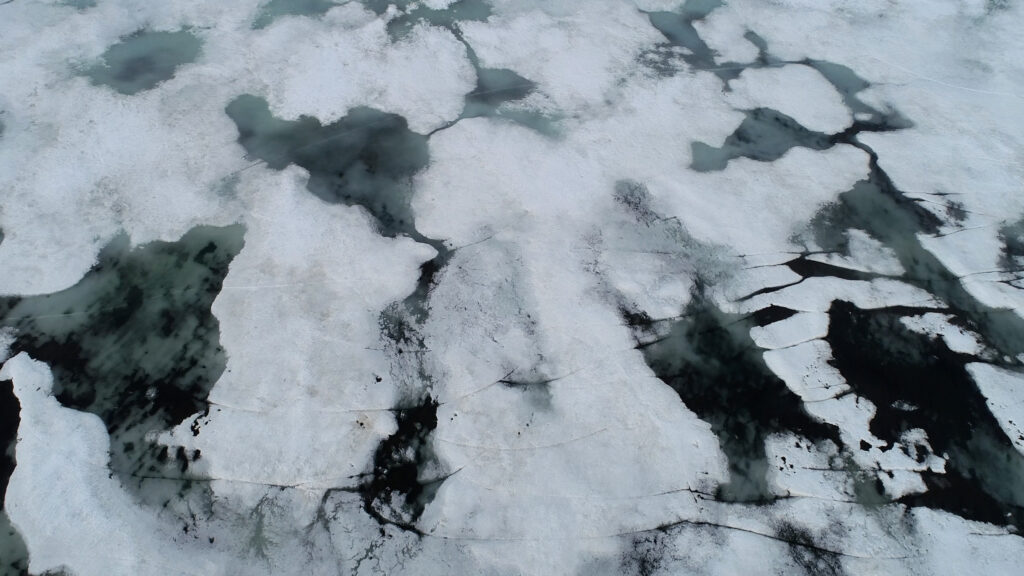
AT/CAN 2024, col & bw, 46 min
What does it mean to represent the visual traces of environmental destruction? How to communicate the temporality of global heating in a time-based medium? These are the questions tackled by Michaela Grill and Karl Lemieux’s experimental documentary exploring permafrost thaw and its effects on diverse ecosystems. The film does not shy away from the gravity of the situation, the title alluding not only to potential futures but equally to a very tangible and disastrous present. Gliding camera movements reminiscent of Grill’s Into the Great White Open reveal the surfaces and contours of Arctic snow-covered landscapes that drift in and out of abstraction, confusing scale and perspective. As we settle into the beauty of the images, it becomes clear that what we are seeing is the great thaw itself, evidenced in the exposed rock faces, the melting ice and the sounds of water that gradually seep through the layers of electronic music. If these opening drone images draw us into a sense of the sublime, the scientific facts presented in a series of intertitles bring us solemnly back down to earth, informing us of the consequences of inaction.
The Great Thaw is ultimately an experiment in documentary filmmaking and a foray into scientific communication. Collaborating with scientific researchers, the filmmakers shift between relaying facts and creating an experience of those facts, allowing the spectator to feel the environmental changes and sense the physical transformations. The interplay of analogue and digital imagery (the media of choice of Lemieux and Grill respectively), combined with the intricately composed soundtrack and the oscillation between abstraction and figuration, opens a space for embodied understandings and the fluid movement of thought. Avoiding the didactic, the film nonetheless wills us to confront reality. As the final intertitle states, quoting from Thomas Halliday’s book Otherlands: A World in the Making, ‘We know that change is occurring, we know that we are responsible, we know what will happen if it continues, we know that we can stop it, and we know how. The question is whether we will try.’ (Kim Knowles)
The Great Thaw is a project about permafrost thaw and how landscape is changed by it. We take a close look at ecosystems like the boreal forest, the tundra and the arctic coastline to document the impacts of the melting permafrost caused by climate change and to present the beauty of permafrost itself. After Antarctic Traces, The Great Thaw is a new part of the Ecological Grief Series which focuses on different aspects of human interaction with nature in the Anthropocene. The series investigates environmental melancholia and the loss of places, species and ecosystems. (MG/KL)
credits:
a film by Michaela Grill and Karl Lemieux
sound recording, sound design and original music: Nick Kuepfer / production: Michaela Grill / scientific advisor: Jennifer Watts, Woodwell Climate Research Centre / additional research and production assistant: Peter Burton / additional camera: Caleb Molinar / image restoration consultant: Patrick Bergeron / additional scientific advisor: Dr. Christopher Burn, Chancellor’s Professor of Geography Carleton University, President International Permafrost Association
with (in order of appearance):
Dr. Alexander L. Kholodov, Permafrost Laboratory, Geophysical Institute, University of Alaska Fairbanks / Valeria Briones, Research Assistant, Woodwell Climate Research Centre / Dr. Jennifer Watts, Ecologist, Woodwell Climate Research Centre / Christina Minions, Research Assistant, Woodwell Climate Research Centre / Anne Yutrzenka, Alaska resident and science teacher / Martin Edwardsen, Arctic Indigenous Traditional Ecological Knowledge Specialist at Ukpeaġvik Iñupiat Corporation Science / Jeremiah Goodwin / Van Edwardsen / Terza Brower
scientific input:
Dr. Gaku Amada, Institute of Arctic Climate and Environment Research, Research Institut for Global Change, Japan Agency for Marine-Earth Science and Technology / Tom Douglas, U.S. Army Corps of Engineers, Permafrost Tunnel / Celtie Ferguson, GIS Technician, Western Arctic Research Centre, Aurora Research Institute / Dr. Helene Genet, Institute of Arctic Biology at University of Alaska Fairbanks / Prof. Stephan Gruber, Geography and Environmental Studies, Carleton University / Nick Hasson, Water and Environmental Research Center at University of Alaska Fairbanks / Adrienne Hill, implementation and governance manager First Nation of Na-Cho Nyäk Dun / Jennifer Humphries, Permafrost Specialist, Western Arctic Research Centre, Aurora Research Institute / Dr. Hideki Kobayashi, Institute of Arctic Climate and Environment Research, Research Institute for Global Change, Japan Agency for Marine-Earth Science and Technology / jake moore, Faculty Member in Art & Art History, Head of University Art Galleries and Art Collection at University of Saskatchewan / Darcy L. Peter, Alaska Conservation Foundation / Dr. Ted Schuur, Ecosystem Science and Society, Department of Biological Sciences at Northern Arizona University
production input:
Chad Diesiger, Assistant Station Manager, Toolik Field Station, Institute of Arctic Biology / Randy Fulweber, GIS & Remote Sensing Manager, Toolik Field Station, Institute of Arctic Biology / Peter C. Griffith, Lead Scientist Arctic Boreal Vulnerability Experiment (ABoVE), NASA Carbon Monitoring System / Torre Jorgenson, Alaska Ecoscience / Krystyna Kozioł, Department of Analytical Chemistry, Gdansk University of Technology / Nikki Lindt / Mia Vlacich, Helo Coordinator, Toolik Field Station, Institute of Arctic Biology / Amanda Young, Spatial & Environmental Data Center Manager, Toolik Field Station, Institute of Arctic Biology
thanks:
Steve Bates / Alexis Cadorette-Vigneau / Gina Deyoung / Mariana Frandsen / Thomas Halliday / Lukas Marxt / Barbara Pichler / Deanna Radford
in memory of Philip Jeck
supported by:
Canada Council for the Arts Research grant / Bm:koes Bildende Kunst, Architektur, Design, Mode, Foto und Medienkunst / Woodwell Climate Research Centre / Stadt Wien Kultur Arbeitsstipendium
festival placements:
Nouveau Cinéma Montréal/CAN, This Human World Vienna/A, Diagonale/A, Frome International Climate Film Festival/UK
screenings:
UN Climate Change Conference COP29 Baku/AZE, NASA ABoVE science meeting, Remai Modern Saskatoon/CAN, Earth (Okâwîmâw Askiy – ᐅᑳᐧᒫᐊᐧᐢᑭᕀ) at University of Saskatchewan Art Galleries
exhibitions:
In Flux: Perspectives on Arctic Change. Highfield Hall/USA, EVA Experimental Video Art Exhibition Bangkok/THA
online:
Labocine/ „The Ecosystem“, Tënk Canada – Le cinéma documentaire en ligne